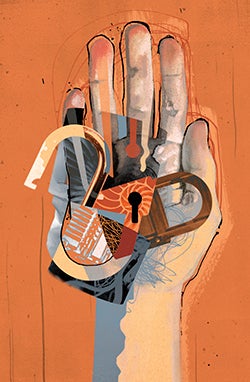
Whack. Whack. Scrape. Scrape. Tap. Tap. Click.
“You hear it?” Tobias Bluzmanis asks the undergraduate mechanical engineering student sitting to his left.
The student, Evan Kaseman, smiles. “A satisfying sound,” he says.
It is 9:30 on a Wednesday night, and a dozen or so people are in room 102 of Benedum Hall learning how to break into things. Bluzmanis and Kaseman are huddled over a generic, cylindrical door lock clamped to the table in front of them. Using thin steel rods with slightly curved ends, they are attempting to move small pins in the lock to their unlocked positions.
Bluzmanis, a locksmith, and his business partner, lawyer Marc Tobias, don’t have a problem with teaching college students how to pick locks. In fact, they believe it is a critical skill for engineers—particularly when it comes to security, which, in one way or another, touches everyone’s life.
“You can’t design a secure product—hardware or software—unless you first understand how to break into those products,” explains Tobias. Through their company, Security Laboratories, Tobias and Bluzmanis work as consultants for the world’s biggest lock manufacturers by first figuring out how to open their clients’ locks without keys and without incurring physical damage. Then, they help them design better locks.
In 2016, Security Laboratories partnered with the Swanson School of Engineering to open the school’s Security Engineering Lab, where undergraduate and graduate engineering students can take an elective course in which they learn how to break things to then make them more secure. The course is co-taught by Tobias, Bluzmanis, and Eric Winter, an assistant professor of industrial engineering.
“We’re trying to impart to these students that everything they do is about liability in product design,” explains Tobias. To do this, Tobias and Bluzmanis have students work on specific design projects for their clients throughout the semester. “These are real-world problems that were made for engineering students,” says Tobias. But he makes it clear that these skills aren’t to be abused. “We won’t come bail you out,” he jokingly warns the students.
Every fall and spring semester, Tobias and Bluzmanis also host a lock-breaking seminar for anyone interested. On this Wednesday night, attendees dig into pizza as they are introduced to the history, concepts, legality, and ethics of the industry. Then, they’re invited to the front of the room, where they find plenty of locks and a multitude of tools with which to break into them.
Tobias and Bluzmanis float among the amateur lock-pickers, including Kaseman, offering advice and answering questions. While Tobias helps Kaseman pick his lock, other students try their hand at bumping—using a small hammer on a special type of key to force the lock’s pins in place.
Conversation dwindles as students focus on the task at hand. Every so often, there is a click, followed by a gasp of success. Kaseman is determined: “I’m not going to leave this spot until this lock is turned.”
This story appeared in the Spring 2019 edition of Pitt Magazine.




